

EduProject - Videos. Log In. Project Based Learning: Explained. 1_S.Giovanni-Persiceto-metodo_Zecchi.pdf. Il Project Based Learning nella scuola: implicazioni, prospettive e criticità. The PDF file you selected should load here if your Web browser has a PDF reader plug-in installed (for example, a recent version of Adobe Acrobat Reader).
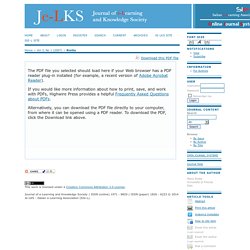
If you would like more information about how to print, save, and work with PDFs, Highwire Press provides a helpful Frequently Asked Questions about PDFs. Alternatively, you can download the PDF file directly to your computer, from where it can be opened using a PDF reader. To download the PDF, click the Download link above. Fullscreen Fullscreen Off This work is licensed under a Creative Commons Attribution 3.0 License. PBL attraverso il metodo Lepida Scuola_IT.
Quali attività deve prevedere un insegnante per lo sviluppo di progetti in classe?

La tabella chesegue contiene le attività, i deliverable attesi e gli strumenti di valutazione coerenti per unaimplementazione essenziale della PBL in classe. Con “essenziale” intendiamo dire di un percorsominimale ma ugualmente significativo. Un’esperienza multidisciplinare di Project Based Learning Collaborativo con Moodle e Cloud (*) A cura di: Giuseppe Fiorentino (fiorent@dm.unipi.it) - Accademia Navale di LivornoDaniela Rotelli e Maria Accarino (daniela.rotelli@istruzione.it, maccarino@gmail.com) Laboratorio di Cultura Digitale, Università di Pisa.
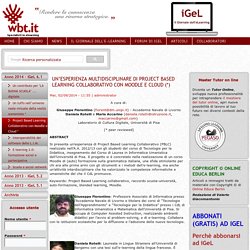
Enzo Zecchi. Le Rubric – enzozecchi. Si prospetta un quadro complessivo delle diverse metodiche di valutazione in classe e all’interno di questo quadro si sviluppa un’analisi approfondita sul significato, sulla progettazione e sull’utilizzo delle rubric, innovativo strumento di valutazione.

Il tutto è preceduto da una discussione sui concetti di apprendimento e valutazione autentici nonché su quello di valutazione delle prestazioni. Le considerazioni esposte si basano tutte, non solo sulla letteratura di riferimento ma anche e soprattutto, su un’esperienza concreta, pluriennale, che l’autore ha condotto all’interno di una scuola superiore e che si rivela fonte di suggerimenti pratici sulla progettazione e l’uso delle rubric stesse. Your Edu Action - L'azione di educare ed imparare. Cos’è il project based learning?

Il PBL è un approccio all’insegnamento che pone maggiormente l’accento sull’apprendimento da esperienze complesse, orientate verso il raggiungimento di uno scopo o di un obiettivo specifico, al contrario dell’approccio accademico tradizionale che promuove la memorizzazione meccanica di molteplici nozioni alienate dai loro usi concreti nel mondo reale. L’obiettivo che si pone il PBL è quello di fornire alle giovani generazioni gli strumenti mentali necessari per far fronte alla complessa e mutevole natura dell’economia basata sull’informazione che dovranno prepararsi ad affrontare. La scuola ti ha mai insegnato come verificare, dubitare e mettere in discussione ogni fonte di informazione?
Ti ha mai insegnato come organizzare al meglio il tuo lavoro se fai parte di un team collaborativo? Www.innovationunit.org/sites/default/files/Teacher's Guide to Project-based Learning.pdf. Project-Based Learning. What is PBL? To help teachers do PBL well, we created a comprehensive, research-based model for PBL — a "gold standard" to help teachers, schools, and organizations to measure, calibrate, and improve their practice.
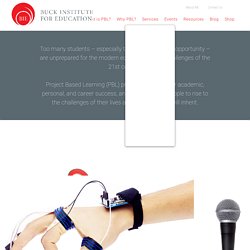
Www.cde-pc.it/documenti/rubric_Zecchi.pdf. Resources. Education-2025 - Project-Based Learning. Project-Based Learning (PBL) "Tell me and I'll forget; show me and I may remember; involve me and I'll understand.
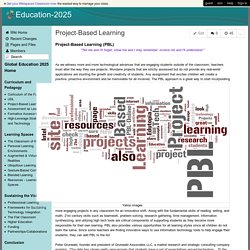
" As we witness more and more technological advances that are engaging students outside of the classroom, teachers must alter the way they use projects. Mundane projects that are strictly assessed but do not provide any real-world applications are stunting the growth and creativity of students. Any assignment that excites children will create a positive, proactive environment and be memorable for all involved. The PBL approach is a great way to start incorporating more engaging projects in any classroom for an innovative shift. Resources for Assessment in Project-Based Learning. Project-based learning (PBL) demands excellent assessment practices to ensure that all learners are supported in the learning process.
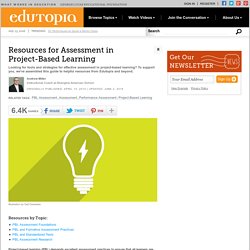
With good assessment practices, PBL can create a culture of excellence for all students and ensure deeper learning for all. We’ve compiled some of the best resources from Edutopia and the web to support your use of assessment in PBL, including information about strategies, advice on how to address the demands of standardized tests, and summaries of the research. PBL Assessment Foundations 10 Tips for Assessing Project-Based Learning (Edutopia, 2011) This comprehensive guide from Edutopia goes over many best practices for assessment, including authentic products, good feedback, formative assessment, and digital tools.
Edutopia-10tips-assessing-project-based-learning.pdf. Resources and Tools for PBL Start to Finish. Tips for downloading: PDF files can be viewed on a wide variety of platforms -- both as a browser plug-in or a stand-alone application -- with Adobe's free Acrobat Reader program.

Click here to download the latest version of Adobe Reader. Documents to Help You Get Started. Project Based Learning. I’ve been teaching using a project-based learning pedagogy since mid-2010 when I was introduced to PBL by my friend, Dean Groom.

Since then I have had some wonderful learning experiences with PBL and I enjoy sharing both my successes and failures and experiments in learning on my blog. I thought it’d be helpful for other people if I put all of my PBL-related posts on one page, just in case you’re starting out and you want to see how another teacher is doing it too. If you have any questions, just post a comment below or send me a tweet on twitter. Feedback, feed-forward, peer-assessment and project-based learning. Last year when I began my Masters of Ed, my lecturer told me that I should read about ‘feedback’. She encouraged me to look at the work of Black and Wiliam (Inside the Black Box being their most well known and eloquent paper on feedback and assessment), Hattie (his book Visible Learning on the effect sizes of a variety of teaching methods revealed ‘feedback’ has the most significant impact on learning) and Petty (who used the research of Hattie and made it practical for the classroom in his book ‘Evidence Based Teaching’).
Publications. The Entrepreneurial School. Keyconet.eun.org/c/document_library/get_file?uuid=d2e33016-9c19-4901-aa00-5d25c5d734f2&groupId=11028. Examples of Project-Based Learning from across Europe. PBL Resources. Project Based Learning. Educational Leadership:Giving Students Meaningful Work:Seven Essentials for Project-Based Learning. Building Parent Support for Project-Based Learning. When a teacher, school or district tells parents, "We're going to do project-based learning," the response may vary. You're lucky if some say, "Great news! Students need to be taught differently these days! " Www.ileohio.org/materials/Documents/authentic culminating products.pdf.
Bringing Authenticity to the Classroom. Photo credit: iStockphoto Authenticity -- we know it works! There is research to support the value of authentic reading and writing. When students are engaged in real-world problems, scenarios and challenges, they find relevance in the work and become engaged in learning important skills and content. In addition, while students may or may not do stuff for Mr. Miller, they are more likely to engage when there is a real-world audience looking at their work, giving them feedback, and helping them improve.
Authentic Products Does the work matter? Rigorous Project-Based Learning Transforms AP Courses. Student: I run the Washington Post. Student: I ran for President. Student: I lobby Congress. Amber: We had one student in my former district who dropped out of high school and came to AP Government every day till the end of the year. And he called himself the worst drop-out in the history of drop-outs, because he still showed up. I don't know why he came. Walter: What we're working on in the Knowledge in Action project is a way of making advanced high school course work accessible to more and more children, and worth it, by making it a deep, rich curriculum that they can take with them into the future. Student: Do we want to say before or against the Alabama law? Student: Our interest group would be before this, before the Alabama, because all it is is collecting data.
Student: It's hard to collect data when people are not forthcoming. Srdc.msstate.edu/trainings/educurricula/commleadership/part2.pdf. Bringing Authenticity to the Classroom. How to Get High-Quality Student Work in PBL. "I thought the project was going well . . . but by the end, I felt that the work my students produced was not as good as I imagined it would be. I was a little embarrassed and almost wanted to dial back the audience's expectations on the night of the presentations! " This is a common concern of teachers who are new to project-based learning. Things can appear to be going smoothly -- students have been engaged by the project, they've been learning content and skills, they've been busy and meeting deadlines -- but their thinking is not as in-depth and their final products not as polished as they should be.
If this is your experience, it's time to ask yourself some questions: 1. Simply telling students that you want them to do high-quality work is not enough, nor is giving them a checklist that tracks completion, not quality. To have students practice using a rubric, find some exemplars of the kind of work required in the project. Here's another tip for clarifying high expectations. 2. Project-Based Learning: Debunking the Myths and Fallacies. More than 20 years of teaching and leading schools that rely on project-based learning (PBL), I have heard many untruths stated as "PBL gospel.
" These fallacies survive as myths that get in the way of opportunities for students to learn and prepare for the world outside of school. To counter these logical fallacies, I have created a list of the most common fallacies and provided arguments for debunking each. The Coverage Fallacy looks and sounds like this: If I cover/teach "it," students learn "it" Students need to master all the content in a subject area in order to be prepared for middle school...high school... and college"How do I know that they learned the content if I do not teach it to them? ""I have too much to cover to spend the time on projects" This fallacy is based on the myth that students will not learn something unless the teacher tells them what to learn.
The Other Fallacies. Project Based Learning (PBL) activities using the “Lepida Scuola” Method – enzozecchi. Pocket : Seven Essentials for Project-Based Learning. Videos. Www.tandfonline.com/doi/pdf/10.1080/03098260500499709. Www.gees.ac.uk/planet/pbl.pdf. Transition from World Geography to Global Studies as PBL via Design Thinking. Your Name and Title: Todd Wass School, Library, or Organization Name: The Lovett School Co-Presenter Name(s): Ben Posten Country from Which You Will Present: United States of America Language in Which You Will Present: English Target Audience (such as primary school teachers, high school administrators, students, etc.): Middle and High School Social Studies Teachers, and Curriculum Specialists Short Session Description (one line): Transition from World Geography to Global Studies as PBL via Design Thinking Full Session Description: A year and a half ago, The Lovett Middle School decided to make a change in its social studies curricular model.
Using a Design Thinking model, active student participation is encouraged through observations, brainstorming, research, experimentation, and above all, collaborating through teamwork. The first year of our Design Thinking model implementation (Design in Motion) occurred in 2011-2012 school year. Follow the link to our presentation: Social Studies Projects & Ideas for PBL History, Geography, Civics. These 350 projects in social studies take your students beyond dioramas and research papers to authentic learning in community and civic problem-solving and world outreach. Your students collaborate with classes across campus, the town or the world to develop solutions, to share international cultures, and to understand local, state, national and world issues.
I got my start on social studies projects with an ePals project. (ePals projects are listed below.) My class paired up with a class in Germany to learn about the culture and geography of Germany and Europe.